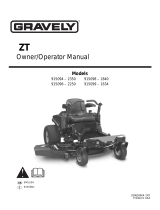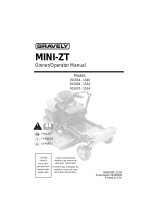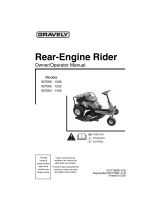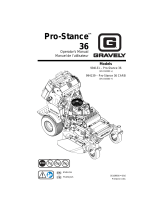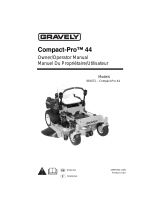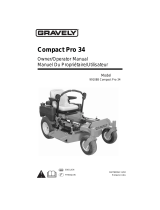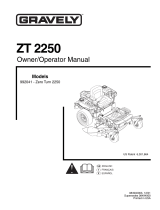
GB - 8
ALWAYS keep hands and feet away from all rotating parts
during operation. Rotating parts can cut off body parts.
ALWAYS keep body and hands away from pin holes or
nozzles which eject hydraulic fluid under pressure.
DO NOT touch parts which are hot. Allow parts to cool.
ALWAYS keep hands and feet away from all pinch points.
Fumes from the engine exhaust can cause death or serious
injury. DO NOT run engine in an enclosed area. Always
provide good ventilation.
Read, understand, and follow all instructions in the manual
and on the machine before starting.
Understand:
• How to operate all controls
• The functions of all controls
• How to STOP in an Emergency
• Braking and steering characteristics
• Turning radius and clearances
Keep safety devices or guards in place and functioning
properly. NEVER modify or remove safety devices.
Do not operate without either entire grass catcher or the
discharge guard in place.
Stop engine before removing grass catcher or unclogging
chute.
Ensure Safety Interlock System is functioning properly. DO
NOT operate unit if safety interlock is damaged or disabled.
Start and operate unit only when seated in operator’s
position. Steering control levers must be in neutral, PTO
disengaged and parking brake set when starting engine.
Use care when approaching blind corners, shrubs, trees or
other objects that may obscure vision.
Dust, smoke, fog, etc. can reduce vision and cause an
accident. Mow only in daylight or good artificial light.
Avoid slippery surfaces. Always be sure of your footing.
DO NOT mow on wet grass. Reduced traction could cause
sliding and effect the machine’s stability.
Watch for traffic when operating near or crossing roadways.
Never carry passengers.
DO NOT try to stabilize the machine by putting your foot on
the ground.
Never direct discharge towards persons or property that may
be injured or damaged by thrown objects. Use extreme
caution on gravel surfaces.
Always stand clear of the discharge area.
ALWAYS disengage PTO, stop unit and engine, remove key,
engage parking brake and allow moving parts to stop before
leaving operator’s position.
Never engage PTO while raising attachment or when
attachment is in raised position.
DO NOT operate at too fast a rate. DO NOT change engine
governor settings or over-speed engine. Slow down before
turning.
DO NOT operate in reverse unless absolutely necessary.
ALWAYS look down and behind before and while backing.
Stop and inspect equipment if you strike an object or if there
is an unusual vibration. Repair, if necessary, before
restarting. Never make adjustments or repairs with the
engine running.
Mower blades are sharp and can cut you. Wrap the blade(s)
or wear gloves, and use extra caution when servicing them.
NEVER weld or straighten mower blades.
Rotation of one blade may cause rotation of the other
blades.
Take all possible precautions when leaving unit unattended.
Shut off engine. Remove wire from spark plug and secure it
away from spark plug.
ALWAYS remove key to prevent unauthorized use.
Know the weight of loads. Limit loads to those you can
safely control and the unit can safely handle.
Disengage PTO when attachment is not in use. ALWAYS
turn off power to attachment when travelling, crossing
driveways, etc.
Mow up and down slopes, not across them.
DO NOT operate on slopes of more than 17 degrees.
Use of a Rollover Protection System (ROPS) is
recommended for slope operation. See Attachments and
Accessories.
Always wear a seat belt when operating unit using a
Rollover Protection System (ROPS).
Keep all movements on the slope slow and gradual. Do not
make sudden changes in speed or direction.
Avoid starting or stopping on the slope. If tires lose traction,
disengage the blades and proceed slowly straight down the
slope.
If you cannot back up a slope or you feel uneasy on it, do not
mow it.
DO NOT park on slopes unless necessary. When parking on
slope always chock or block wheels. Always set parking
brake.
Use a slow speed. Tires may lose traction on slopes even
though the brakes are functioning properly.
Do not bypass transmission when on a slope.
Tow only with a machine that has a hitch designed for
towing. Do not attach towed equipment except at the hitch
point.
Follow the manufacturer’s recommendations for weight
limits for towed equipment and towing on slopes.
NEVER allow children or others in or on towed equipment.
On slopes, the weight of the towed equipment may cause
loss of control.
Travel slowly and allow extra distance to stop.
Use extra care when loading or unloading unit onto trailer or
truck.
Secure unit chassis to transport vehicle. NEVER secure
from rods or linkages that could be damaged.




















